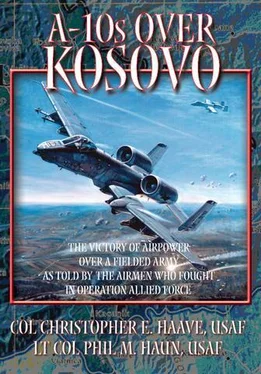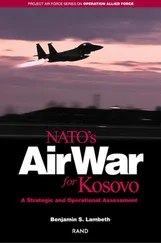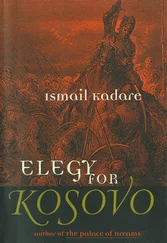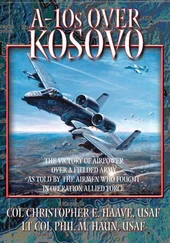The second innovation was the F-111F’s introduction of “tank plinking.” Targets could be located and attacked from medium altitude with infrared targeting pods and laser-guided bombs. [24] Keaney and Cohen, Summary Report , 21; Andrews, 54; and Fred L. Frostic, Air Campaign against the Iraqi Army in the Kuwaiti Theater of Operations , Rand Report MR-357-AF (Santa Monica, Calif.: RAND, 1994). F-111Fs developed the tank-plinking tactic using their Pave Tack laser designator. Lessons learned during a Desert Shield exercise had shown the potential for identifying and targeting armor from medium altitude. On 5 February, two F-111Fs successfully dropped two GBU-12s on revetted positions. Within three days, 50 sorties a night were devoted to tank plinking. Navy A-6Es began dropping a limited number of LGBs, as did F-15E crews. The F-15Es were limited by the number of LANTIRN pods and quickly developed buddy lasing techniques.
The pods could clearly distinguish the infrared image of the warm Iraqi armor against the cold desert background. [25] Andrews, 56.
This method provided the additional advantage of using targeting-pod video to verify successful attacks and boost BDA estimates.
The final tactical innovation reintroduced the Fast FAC mission. F-16CG (Block 40s) from Hill AFB, Utah, began flying as “Killer Scouts.” [26] AFDD 2-1.3, 102. Counterland doctrine now incorporates the Killer Scout mission.
This innovation mirrored the Misty FAC hunter-killer tactics during Vietnam but was renamed to avoid confusion with hunter-killer SEAD tactics currently used by F-4G Wild Weasels and F-16s. Killer Scouts took off early and reconnoitered their assigned kill boxes. They were allocated sufficient air-refueling tankers to remain on station for long periods to become familiar with the territory and increase their situational awareness. Like the Misty FACs, the Killer Scouts carried a minimum munitions load to reduce drag and increase endurance. When they identified Iraqi positions, they usually brought in F-16 strikers for the attack. Along with identifying viable target areas for attack, they also assisted in the collection of BDA. To do that, the Killer Scouts relied primarily on their own eyes, aided somewhat by binoculars. Unfortunately, operating at medium altitude made it difficult to accurately determine the number of targets destroyed. The Killer Scout role had its limitations, but this innovation led to the more efficient use of F-16s against Iraqi fielded forces.
Following the Gulf War, the USAF remained deployed in Southwest Asia, maintained two no-fly zones over Iraq, and responded to sporadic infringements by Saddam Hussein’s remaining forces. Elsewhere, the dissolution of Yugoslavia and the Bosnian Serbs’ ethnic cleansing of Muslims in April of 1992 led to the US military’s involvement with the UN peacekeeping force in Bosnia. Meanwhile famine in war-torn Somalia brought a US military presence to Mogadishu from December 1992 until its hasty withdrawal in May of 1994. In September of 1995, US airpower was again needed. This time Operation Deliberate Force, an 11-day campaign, helped force Serbia to accept the Dayton Peace Accords. [27] Col Robert C. Owen, ed., Deliberate Force: A Case Study in Effective Air Campaigning (Maxwell AFB, Ala.: Air University Press, 2000), xvii.
By the late ’90s, NATO was convinced that airpower was an effective tool to coerce Slobodan Milosevic, the Serbian president, and that it might be needed to solve the growing unrest in Kosovo.
Kosovo: Direct Attack of the Serbian Third Army
Tensions between Belgrade and Kosovo increased during the late 1980s. Slobodan Milosevic used protests by minority Serbs residing in the ethnically Albanian-dominated province as the foundation for his Serbian nationalist platform and his subsequent rise to the Serbian presidency in 1987. [28] Noel Malcolm, Kosovo: A Short History (New York: New York University Press, 1998), 341.
By 1989, Belgrade had revoked Kosovo’s status as an autonomous region and placed restrictions on land ownership and government jobs for Kosovo Albanians. [29] Tim Judah, Kosovo: War and Revenge (New Haven, Conn.: Yale University Press, 2000), 62.
During the 1990s, Kosovar dissension spawned a series of both violent and nonviolent protest. [30] For purposes of this discussion, the term Kosovars refers to Kosovar Albanians.
Opposition became violent in 1997 with the formation of a small group of lightly armed guerrilla fighters known as the KLA. In response to KLA ambushes of Serbian police in early 1998, Serbian forces conducted brutal retaliatory attacks against suspected KLA positions. [31] William Buckley, ed., Kosovo: Contending Voices on Balkan Interventions (Grand Rapids, Mich.: William B. Eerdmans Pub. Co., 2000), 100. For purposes of this discussion, the terms Serbia and Serbian will be used to refer to those forces from the Federal Republic of Yugoslav. Likewise Macedonia will be used to refer to the Former Yugoslav Republic of Macedonia.
KLA support swelled within Kosovo and led to an escalation of KLA activity. In July of 1998, Serbian forces conducted a village-by-village search for KLA members, displacing over 200,000 Kosovars in the process. [32] Judah, 171.
The magnitude of the humanitarian crisis captured the attention of the international community.
In response to the KLA and Serbian exchanges, the UN Security Council passed Resolution 1160 in March 1998 and Resolution 1199 in September 1998. The resolutions condemned Serbia’s excessive use of force, established an arms embargo, and called for an immediate cease-fire and the introduction of international monitors. [33] United Nations Security Council Resolution (UNSCR) 1160, 1998, n.p., on-line, Internet, 15 November 2001, available from http://www.un.org/Docs/scres/1998/sres1160.htm ; UNSCR 1199, 1998, n.p., on-line, Internet, 15 November 2001, available from http://www.un.org/Docs/scres/1998/sres1199.htm .
The latter demand was met in the cease-fire negotiated between US envoys and Belgrade in October 1998. [34] Dick Leurdijk and Dick Zandee, Kosovo: From Crisis to Crisis (Burlington, Vt.: Ashgate Pub. Co., 2001), 34; and US Department of State, Erasing History: Ethnic Cleansing in Kosovo (Washington, D.C.: US Department of State, May 1999), 6, on-line, Internet, 10 December 2002, available from http://www.state.gov/www/regions/eur/rpt_9905_ethnic_ksvo_toc.html . Though 2,000 observers of the Organization for Security and Cooperation in Europe (OSCE) had agreed to participate, OSCE was never able to get that many into country before their withdrawal in March 1999.
However, the massacre of 45 Kosovar Albanians at Racak on 19 January 1999 quickly brought the cease-fire to an end. [35] Albert Schnabel and Ramesh Thakur, eds., Kosovo and the Challenge of Humanitarian Intervention: Selective Indignation, Collective Action, and International Citizenship (New York: United Nations University Press, 2000), 35.
Under threat of NATO air strikes, Serbian and Kosovar representatives were summoned to Rambouillet, France, to negotiate a peace agreement. [36] Judah, 195. The Serbs were threatened by the air strikes if they did not come to an agreement, and the Kosovars were threatened that NATO would leave them to the mercy of the Serbs if they did not sign.
The compromise included the key items of a NATO-led implementation force; the recognition of the international borders of the Former Republic of Yugoslavia, made up of Serbia, Montenegro, and Kosovo; and an interim three-year agreement, after which a final settlement of Kosovo could be arranged. [37] Ibid., 206.
The Kosovar delegation initially refused to agree unless reference was made to a future referendum to decide the fate of Kosovo. Under the threat of the withdrawal of international support, including financial and military aid to the KLA, the Kosovar delegates reluctantly signed on 18 March 1999. [38] Ministry of Defence (MOD), Kosovo: Lessons from the Crisis (London: Her Majesty’s Stationery Office, 2000), 9.
The Serbs, unwilling to accept a NATO-led military force within Kosovo, remained recalcitrant. In the face of diplomatic impasse, NATO air strikes were ordered to commence on 24 March.
Читать дальше












